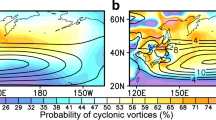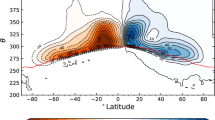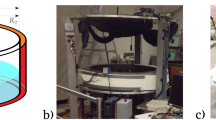Abstract
FIVE or six years ago, in reports to the Meteorological Research Committee, I analysed the air-mass transport in vertical cross-sections of the circulations between cyclones and anticyclones1. One of the results reached was that the horizontal air-mass transport (ρv) reaches a maximum, not at the tropopause, but rather lower, often at about the 8-km. level. This level, indeed, seems to be the boundary between two circulations in the vertical plane; the lower circulation involves upward motion in the cyclone, thence horizontal transfer towards the anticyclone, thence subsidence in the anticyclone; the upper circulation involves subsidence in the cyclone, including subsidence in the stratosphere, thence horizontal transfer towards the anticyclone, thence ascent of air, both in the upper part of the troposphere and in the stratosphere of the anticyclone. The influence of such circulations in causing variations in the height of the tropopause was discussed.
This is a preview of subscription content, access via your institution
Access options
Subscribe to this journal
Receive 51 print issues and online access
$199.00 per year
only $3.90 per issue
Buy this article
- Purchase on Springer Link
- Instant access to full article PDF
Prices may be subject to local taxes which are calculated during checkout
Similar content being viewed by others
References
A summary is given in the November and December 1949 issues of Weather.
J. Meteorology, 6, No. 4 (1949).
Author information
Authors and Affiliations
Rights and permissions
About this article
Cite this article
GOLDIE, A. ? A Fundamental Property of Atmospheric Circulation. Nature 165, 481–482 (1950). https://doi.org/10.1038/165481a0
Issue Date:
DOI: https://doi.org/10.1038/165481a0
This article is cited by
-
Dielectric Absorption of Microwaves in Human Tissues
Nature (1968)
-
Dielectric Absorption of Microwaves in Human Tissues
Nature (1967)
Comments
By submitting a comment you agree to abide by our Terms and Community Guidelines. If you find something abusive or that does not comply with our terms or guidelines please flag it as inappropriate.



